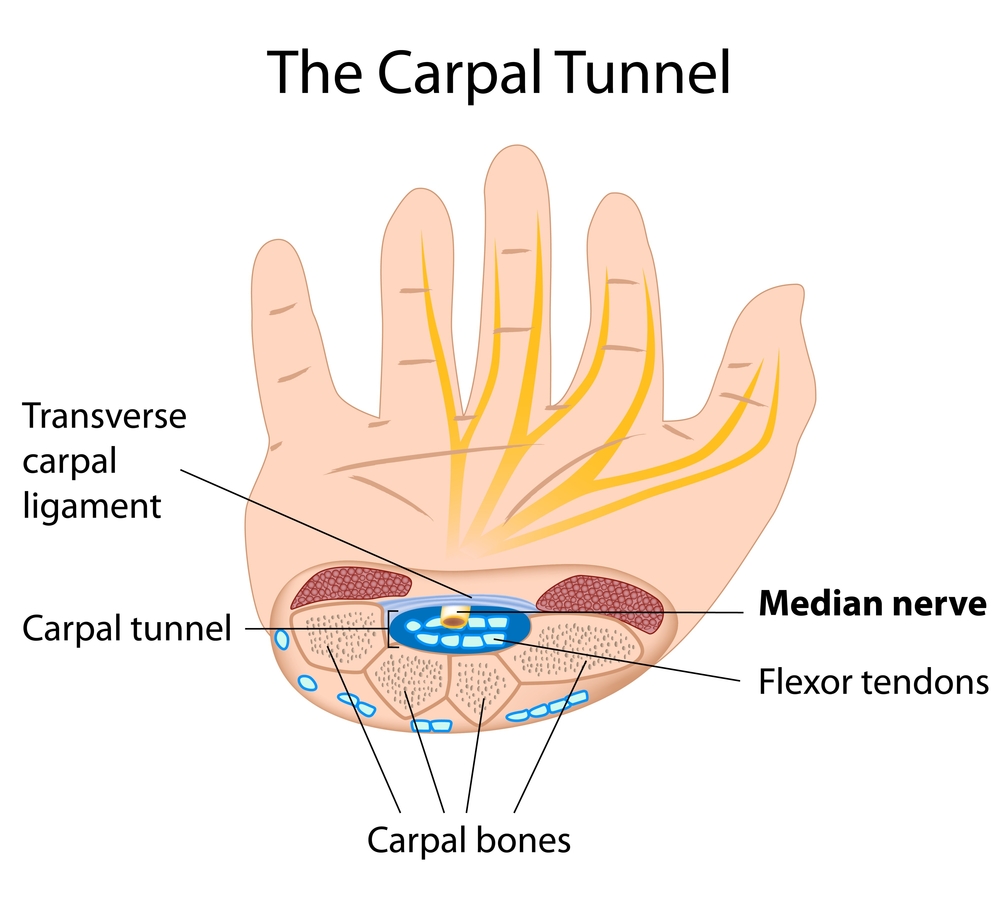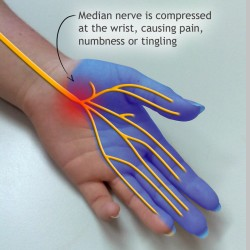Do you spend much time typing at work? Are you a construction worker who operates a jackhammer? Do you have arthritis that affects your wrist? Do you have occasional or constant numbness or tingling in your hand or wrist or pain that shoots up your wrist into your arm? If so I’d hope that you’ve had at least a passing conversation about carpal tunnel syndrome (CTS), a fairly common condition associated with work activities. CTS is part of a class of disorders called entrapment neuropathies.
Let’s review CTS by addressing common questions about the syndrome.
What is carpal tunnel syndrome?
CTS is basically a squeezing of the nerve (median nerve) that extends from the forearm to the palm; the pressure on the nerve occurs at the level of the wrist. The carpal tunnel is an area at the base of the hand (on the side of the thumb) that houses tendons and the median nerve. Because it is such a small space, irritation such as that which occurs from inflammation or injury can compress and/or pinch the median nerve.
What are the causes of CTS?
Your anatomy sets the table for CTS in some cases. Some individuals simply are predisposed to CTS because of a smaller carpel tunnel. Beyond this, conditions that cause injury to the wrist and result in swelling are likely culprits; that said, in some cases no cause is identified. Known causes and/or contributors include the following.
- Development of a cyst or tumor in the canal
- Fluid retention during pregnancy or menopause
- Fracture or sprain
- Hypothyroidism
- Overactivity of the pituitary gland
- Repeated use of vibrating hand tools
- Rheumatoid arthritis
- Work stress
Interestingly and contrary to the popular narrative, there is little clinical data to prove that repetitive and forceful movements of the hand and wrist during work or leisure activities can cause CTS. However, it does stand to reason that if you have CTS, these activities can exacerbate the situation.
What are the symptoms of carpal tunnel syndrome?
Symptoms are easy to figure out if you view your nerve as electrical conductors of various signals caused by stimulation. Frequent burning, tingling, or itching starts gradually, as does numbness in the palm of the hand and the fingers, especially the thumb, index and middle fingers. Symptoms may begin at work or during the night (if you sleep with your wrists cupped). Other symptoms may include a sensation of hand swelling without visual evidence, hand tingling that progressively worsens throughout the day and decreased grip strength. Over time, some untreated patients may lose the ability to distinguish between hot and cold sensations by touch. Symptoms are usually first seen in the dominant hand.
Who is at risk of developing carpal tunnel syndrome?
- Women are three times more likely than men to develop CTS.
- Diabetics or those with other disorders directly affect the body’s nerves are more susceptible to nerve compression.
- CTS usually occurs only in adults.
- CTS is especially common in those performing assembly line work , such as manufacturing, sewing, finishing, cleaning and packing (e.g. meat, poultry, or fish). In fact, CTS is three times more common among assemblers than among data-entry personnel.
The next Straight, No Chaser will address prevention and treatment of carpal tunnel syndrome.
Thanks for liking and following Straight, No Chaser! This public service provides a sample of what 844-SMA-TALK and http://www.SterlingMedicalAdvice.com (SMA) offers. Please share our page with your friends on WordPress, Facebook @ SterlingMedicalAdvice.com and Twitter at @asksterlingmd.
Copyright © 2014 · Sterling Initiatives, LLC · Powered by WordPress.





